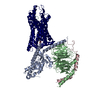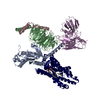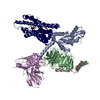登録情報 データベース : PDB / ID : 7t6tタイトル Structure of the human FPR1-Gi complex with fMLFII (Guanine nucleotide-binding protein ...) x 3 Synthetic peptide fMet-Leu-Phe receptor キーワード / / 機能・相同性 分子機能 ドメイン・相同性 構成要素
/ / / / / / / / / / / / / / / / / / / / / / / / / / / / / / / / / / / / / / / / / / / / / / / / / / / / / / / / / / / / / / / / / / / / / / / / / / / / / / / / / / / / / / / / / / / / / / / / / / / / / / / / / / / / / / / / / / / / / / / / / / / / / / / / / / / / / / / / / / / / / / / / / / / / / / / / 生物種 Homo sapiens (ヒト)Rattus (クマネズミ属)Bos taurus (ウシ)Homo (ヒト属)手法 / / / 解像度 : 3.2 Å データ登録者 Zhuang, Y.W. 資金援助 組織 認可番号 国 National Institutes of Health/National Institute of General Medical Sciences (NIH/NIGMS) R35GM128641
ジャーナル : Nat Commun / 年 : 2022タイトル : Molecular recognition of formylpeptides and diverse agonists by the formylpeptide receptors FPR1 and FPR2.著者 : Youwen Zhuang / Lei Wang / Jia Guo / Dapeng Sun / Yue Wang / Weiyi Liu / H Eric Xu / Cheng Zhang / 要旨 : The formylpeptide receptors (FPRs) mediate pattern recognition of formylated peptides derived from invading pathogens or mitochondria from dead host cells. They can also sense other structurally ... The formylpeptide receptors (FPRs) mediate pattern recognition of formylated peptides derived from invading pathogens or mitochondria from dead host cells. They can also sense other structurally distinct native peptides and even lipid mediators to either promote or resolve inflammation. Pharmacological targeting of FPRs represents a novel therapeutic approach in treating inflammatory diseases. However, the molecular mechanisms underlying FPR ligand recognition are elusive. We report cryo-EM structures of G-coupled FPR1 and FPR2 bound to a formylpeptide and G-coupled FPR2 bound to two synthetic peptide and small-molecule agonists. Together with mutagenesis data, our structures reveal the molecular mechanism of formylpeptide recognition by FPRs and structural variations of FPR1 and FPR2 leading to their different ligand preferences. Structural analysis also suggests that diverse FPR agonists sample a conserved activation chamber at the bottom of ligand-binding pockets to activate FPRs. Our results provide a basis for rational drug design on FPRs. 履歴 登録 2021年12月14日 登録サイト / 処理サイト 改定 1.0 2022年3月30日 Provider / タイプ 改定 1.1 2022年10月19日 Group / Structure summary / カテゴリ / citation_author / structItem _citation.country / _citation.journal_abbrev ... _citation.country / _citation.journal_abbrev / _citation.journal_id_CSD / _citation.journal_id_ISSN / _citation.journal_volume / _citation.page_first / _citation.page_last / _citation.pdbx_database_id_DOI / _citation.pdbx_database_id_PubMed / _citation.title / _citation.year / _struct.title
すべて表示 表示を減らす
 データを開く
データを開く 基本情報
基本情報 要素
要素 キーワード
キーワード SIGNALING PROTEIN /
SIGNALING PROTEIN /  GPCR (Gタンパク質共役受容体) /
GPCR (Gタンパク質共役受容体) /  membrane protein (膜タンパク質)
membrane protein (膜タンパク質) 機能・相同性情報
機能・相同性情報 complement receptor activity / scavenger receptor binding /
complement receptor activity / scavenger receptor binding /  RAGE receptor binding / complement receptor mediated signaling pathway / G-protein activation / Activation of the phototransduction cascade / Glucagon-type ligand receptors / Thromboxane signalling through TP receptor / Sensory perception of sweet, bitter, and umami (glutamate) taste ...N-formyl peptide receptor activity /
RAGE receptor binding / complement receptor mediated signaling pathway / G-protein activation / Activation of the phototransduction cascade / Glucagon-type ligand receptors / Thromboxane signalling through TP receptor / Sensory perception of sweet, bitter, and umami (glutamate) taste ...N-formyl peptide receptor activity /  complement receptor activity / scavenger receptor binding /
complement receptor activity / scavenger receptor binding /  RAGE receptor binding / complement receptor mediated signaling pathway / G-protein activation / Activation of the phototransduction cascade / Glucagon-type ligand receptors / Thromboxane signalling through TP receptor / Sensory perception of sweet, bitter, and umami (glutamate) taste / G beta:gamma signalling through PI3Kgamma / G beta:gamma signalling through CDC42 / Cooperation of PDCL (PhLP1) and TRiC/CCT in G-protein beta folding / Activation of G protein gated Potassium channels / Ca2+ pathway / Inhibition of voltage gated Ca2+ channels via Gbeta/gamma subunits / G alpha (z) signalling events / Vasopressin regulates renal water homeostasis via Aquaporins / Glucagon-like Peptide-1 (GLP1) regulates insulin secretion / Adrenaline,noradrenaline inhibits insulin secretion / ADP signalling through P2Y purinoceptor 12 / Formyl peptide receptors bind formyl peptides and many other ligands / G alpha (q) signalling events / G alpha (i) signalling events / Thrombin signalling through proteinase activated receptors (PARs) / Activation of G protein gated Potassium channels / G-protein activation / G beta:gamma signalling through PI3Kgamma / Prostacyclin signalling through prostacyclin receptor / G beta:gamma signalling through PLC beta / ADP signalling through P2Y purinoceptor 1 / Thromboxane signalling through TP receptor / Presynaptic function of Kainate receptors / G beta:gamma signalling through CDC42 / Inhibition of voltage gated Ca2+ channels via Gbeta/gamma subunits / Glucagon-type ligand receptors /
RAGE receptor binding / complement receptor mediated signaling pathway / G-protein activation / Activation of the phototransduction cascade / Glucagon-type ligand receptors / Thromboxane signalling through TP receptor / Sensory perception of sweet, bitter, and umami (glutamate) taste / G beta:gamma signalling through PI3Kgamma / G beta:gamma signalling through CDC42 / Cooperation of PDCL (PhLP1) and TRiC/CCT in G-protein beta folding / Activation of G protein gated Potassium channels / Ca2+ pathway / Inhibition of voltage gated Ca2+ channels via Gbeta/gamma subunits / G alpha (z) signalling events / Vasopressin regulates renal water homeostasis via Aquaporins / Glucagon-like Peptide-1 (GLP1) regulates insulin secretion / Adrenaline,noradrenaline inhibits insulin secretion / ADP signalling through P2Y purinoceptor 12 / Formyl peptide receptors bind formyl peptides and many other ligands / G alpha (q) signalling events / G alpha (i) signalling events / Thrombin signalling through proteinase activated receptors (PARs) / Activation of G protein gated Potassium channels / G-protein activation / G beta:gamma signalling through PI3Kgamma / Prostacyclin signalling through prostacyclin receptor / G beta:gamma signalling through PLC beta / ADP signalling through P2Y purinoceptor 1 / Thromboxane signalling through TP receptor / Presynaptic function of Kainate receptors / G beta:gamma signalling through CDC42 / Inhibition of voltage gated Ca2+ channels via Gbeta/gamma subunits / Glucagon-type ligand receptors /  alkylglycerophosphoethanolamine phosphodiesterase activity / Adrenaline,noradrenaline inhibits insulin secretion / G alpha (12/13) signalling events / G beta:gamma signalling through BTK / ADP signalling through P2Y purinoceptor 12 / Cooperation of PDCL (PhLP1) and TRiC/CCT in G-protein beta folding / Thrombin signalling through proteinase activated receptors (PARs) / Ca2+ pathway / G alpha (z) signalling events / Extra-nuclear estrogen signaling / G alpha (s) signalling events / G alpha (q) signalling events / azurophil granule membrane / photoreceptor outer segment membrane / G alpha (i) signalling events / Glucagon-like Peptide-1 (GLP1) regulates insulin secretion /
alkylglycerophosphoethanolamine phosphodiesterase activity / Adrenaline,noradrenaline inhibits insulin secretion / G alpha (12/13) signalling events / G beta:gamma signalling through BTK / ADP signalling through P2Y purinoceptor 12 / Cooperation of PDCL (PhLP1) and TRiC/CCT in G-protein beta folding / Thrombin signalling through proteinase activated receptors (PARs) / Ca2+ pathway / G alpha (z) signalling events / Extra-nuclear estrogen signaling / G alpha (s) signalling events / G alpha (q) signalling events / azurophil granule membrane / photoreceptor outer segment membrane / G alpha (i) signalling events / Glucagon-like Peptide-1 (GLP1) regulates insulin secretion /  spectrin binding / Vasopressin regulates renal water homeostasis via Aquaporins / Interleukin-10 signaling / ficolin-1-rich granule membrane / photoreceptor outer segment / Adenylate cyclase inhibitory pathway / positive regulation of protein localization to cell cortex / regulation of cAMP-mediated signaling / D2 dopamine receptor binding / G protein-coupled serotonin receptor binding / regulation of mitotic spindle organization / nitric oxide mediated signal transduction / cellular response to forskolin / cardiac muscle cell apoptotic process / photoreceptor inner segment / adenylate cyclase-inhibiting G protein-coupled receptor signaling pathway / secretory granule membrane / Regulation of insulin secretion / G protein-coupled receptor activity / G protein-coupled receptor binding / G-protein beta/gamma-subunit complex binding / adenylate cyclase-modulating G protein-coupled receptor signaling pathway / ADP signalling through P2Y purinoceptor 12 / response to peptide hormone / Adrenaline,noradrenaline inhibits insulin secretion / G alpha (z) signalling events / cellular response to catecholamine stimulus / ADORA2B mediated anti-inflammatory cytokines production / sensory perception of taste / adenylate cyclase-activating dopamine receptor signaling pathway / cellular response to prostaglandin E stimulus / GPER1 signaling / GDP binding / G-protein beta-subunit binding /
spectrin binding / Vasopressin regulates renal water homeostasis via Aquaporins / Interleukin-10 signaling / ficolin-1-rich granule membrane / photoreceptor outer segment / Adenylate cyclase inhibitory pathway / positive regulation of protein localization to cell cortex / regulation of cAMP-mediated signaling / D2 dopamine receptor binding / G protein-coupled serotonin receptor binding / regulation of mitotic spindle organization / nitric oxide mediated signal transduction / cellular response to forskolin / cardiac muscle cell apoptotic process / photoreceptor inner segment / adenylate cyclase-inhibiting G protein-coupled receptor signaling pathway / secretory granule membrane / Regulation of insulin secretion / G protein-coupled receptor activity / G protein-coupled receptor binding / G-protein beta/gamma-subunit complex binding / adenylate cyclase-modulating G protein-coupled receptor signaling pathway / ADP signalling through P2Y purinoceptor 12 / response to peptide hormone / Adrenaline,noradrenaline inhibits insulin secretion / G alpha (z) signalling events / cellular response to catecholamine stimulus / ADORA2B mediated anti-inflammatory cytokines production / sensory perception of taste / adenylate cyclase-activating dopamine receptor signaling pathway / cellular response to prostaglandin E stimulus / GPER1 signaling / GDP binding / G-protein beta-subunit binding /  heterotrimeric G-protein complex /
heterotrimeric G-protein complex /  走化性 / signaling receptor complex adaptor activity / retina development in camera-type eye /
走化性 / signaling receptor complex adaptor activity / retina development in camera-type eye /  GTPase binding / phospholipase C-activating G protein-coupled receptor signaling pathway /
GTPase binding / phospholipase C-activating G protein-coupled receptor signaling pathway /  細胞皮質 /
細胞皮質 /  cell body / midbody / G alpha (i) signalling events / positive regulation of cytosolic calcium ion concentration / cellular response to hypoxia / G alpha (s) signalling events / cell population proliferation
cell body / midbody / G alpha (i) signalling events / positive regulation of cytosolic calcium ion concentration / cellular response to hypoxia / G alpha (s) signalling events / cell population proliferation
 Homo sapiens (ヒト)
Homo sapiens (ヒト)
 Rattus (クマネズミ属)
Rattus (クマネズミ属)
 Bos taurus (ウシ)
Bos taurus (ウシ)
 Homo (ヒト属)
Homo (ヒト属) 電子顕微鏡法 /
電子顕微鏡法 /  単粒子再構成法 /
単粒子再構成法 /  クライオ電子顕微鏡法 / 解像度: 3.2 Å
クライオ電子顕微鏡法 / 解像度: 3.2 Å  データ登録者
データ登録者 米国, 1件
米国, 1件  引用
引用 ジャーナル: Nat Commun / 年: 2022
ジャーナル: Nat Commun / 年: 2022

 構造の表示
構造の表示 Molmil
Molmil Jmol/JSmol
Jmol/JSmol ダウンロードとリンク
ダウンロードとリンク ダウンロード
ダウンロード 7t6t.cif.gz
7t6t.cif.gz PDBx/mmCIF形式
PDBx/mmCIF形式 pdb7t6t.ent.gz
pdb7t6t.ent.gz PDB形式
PDB形式 7t6t.json.gz
7t6t.json.gz PDBx/mmJSON形式
PDBx/mmJSON形式 その他のダウンロード
その他のダウンロード https://data.pdbj.org/pub/pdb/validation_reports/t6/7t6t
https://data.pdbj.org/pub/pdb/validation_reports/t6/7t6t ftp://data.pdbj.org/pub/pdb/validation_reports/t6/7t6t
ftp://data.pdbj.org/pub/pdb/validation_reports/t6/7t6t リンク
リンク 集合体
集合体
 要素
要素
 Homo sapiens (ヒト) / 遺伝子: GNAI1 / 発現宿主:
Homo sapiens (ヒト) / 遺伝子: GNAI1 / 発現宿主: 
 Spodoptera (蝶・蛾) / 参照: UniProt: P63096
Spodoptera (蝶・蛾) / 参照: UniProt: P63096
 Rattus (クマネズミ属) / 遺伝子: Gnb1 / 発現宿主:
Rattus (クマネズミ属) / 遺伝子: Gnb1 / 発現宿主: 
 Spodoptera (蝶・蛾) / 参照: UniProt: P54311
Spodoptera (蝶・蛾) / 参照: UniProt: P54311
 Bos taurus (ウシ) / 遺伝子: GNG2 / 発現宿主:
Bos taurus (ウシ) / 遺伝子: GNG2 / 発現宿主: 
 Spodoptera (蝶・蛾) / 参照: UniProt: P63212
Spodoptera (蝶・蛾) / 参照: UniProt: P63212

 ペプチド合成
ペプチド合成
 Homo (ヒト属)
Homo (ヒト属)
 Homo sapiens (ヒト) / 遺伝子: FPR1 / 発現宿主:
Homo sapiens (ヒト) / 遺伝子: FPR1 / 発現宿主: 
 Spodoptera (蝶・蛾) / 参照: UniProt: P21462
Spodoptera (蝶・蛾) / 参照: UniProt: P21462 パルミチン酸
パルミチン酸 電子顕微鏡法
電子顕微鏡法 単粒子再構成法
単粒子再構成法 試料調製
試料調製
 Spodoptera (蝶・蛾)
Spodoptera (蝶・蛾) : NO / 凍結
: NO / 凍結 : YES
: YES
 電子顕微鏡撮影
電子顕微鏡撮影
 :
:  FIELD EMISSION GUN / 加速電圧: 300 kV / 照射モード: FLOOD BEAM
FIELD EMISSION GUN / 加速電圧: 300 kV / 照射モード: FLOOD BEAM Bright-field microscopy / 最大 デフォーカス(公称値): 5000 nm / 最小 デフォーカス(公称値): 500 nm
Bright-field microscopy / 最大 デフォーカス(公称値): 5000 nm / 最小 デフォーカス(公称値): 500 nm 解析
解析

 ムービー
ムービー コントローラー
コントローラー










 PDBj
PDBj

























